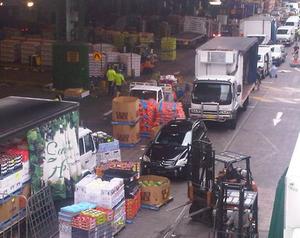The food we eatTechnology tracks produce from growth to delivery
The new federal food safety bill has sparked a technology race among companies to provide simple electronic tracking systems for individual items of produce; the new law mandates that each part of the supply chain keep electronic records of where they received items from and where they shipped it to; this comes as a result of a large salmonella outbreak in 2008 that reached more than forty states and infected more than 1,300 people; poor records led to misidentification and slow recalls in that outbreak; every year 3,000 people die from food-borne illnesses while one in six people suffer from food poisoning

Produce must move in a short time frame // Source: freshplaza.com
The recent federal food safety bill passed by Congress has set off a race among companies to provide technology to track individual items of produce from the field to the supermarket shelf.
The new law contains a provision, dubbed “one step forward, one step back,” that requires every part of the complex U.S. food supply chain to be able to quickly trace where they received a food item from and where they sent it to.
This provision is designed to aid in the speedy identification and recall of contaminated food items that have caused deadly food-borne outbreaks. A recently released CDC study shows that roughly 3,000 people a year die from food-borne illnesses, while one in six Americans get sick from food every year.
According to FDA commissioner Dr. Margeret A. Hamburg, “food borne illnesses and deaths are preventable, and as such, are unacceptable.”
“We must, and can, do better by intensifying our efforts to implement measures that are prevention-oriented and science-based,” she said.
The increased call for greater accountability comes on the heels of a large national outbreak of salmonella food poisoning in 2008 that affected more than 1,300 people in over forty states and took months to identify.
The Federal Drug Administration (FDA) and the Centers for Disease Control and Prevention (CDC) initially incorrectly identified tomatoes as the source of infection. More than a month later, after people continued to become sick, the FDA and the CDC discovered that peppers from Mexico were the real cause of the outbreak.
The incorrect recall of tomatoes cost tomato growers in Florida alone an estimated $100 million.
The delay and the misidentification were due largely to poor record keeping and miscommunication between growers, distributors, wholesalers, and retailers.
The new law will require that every part of the food chain adhere to federal standards and maintain electronic records, forcing smaller business to upgrade their paper invoice systems, and for some their simple handshake agreements.
Technology companies are racing to enter the market for food identification technology that has been vastly expanded by this bill.
David Acheson, former FDA assistant commissioner for food protection, says that, “Somebody is probably going to make a bundle of money out of this.” Each company believes that they “have the holy grail product tracking solutions sitting in their laptop.”
Companies are experimenting with various solutions that range from radio frequency identification tags to etching identification codes on produce with lasers.
The new provision requires, the FDA to launch pilot projects in September 2011 before issuing final guidelines for food tracking standards and regulations by 2013.
Beginning in 2005, portions of the food industry – meat, poultry, eggs – have already been required to electronically track and manage their products. But based on a 2009 Department of Health and Human Service inspector general report, most food facilities failed to meet mandated requirements and 25 percent were not even aware of the law.
While some companies are failing to comply, others are rapidly pressing ahead with increased transparency and passing the benefits to end consumers.
Companies like HarvestMark and Kroger have enabled shoppers to scan a bar code sticker on an individual piece of produce with their smart phone and immediately trace the lifecycle of that item from growth to final delivery.
HarvestMark has made a simple bar code sticker that can be placed on individual fruits, vegetables, or packaging that is recorded in its electronic database. Individuals can access this database either through their smart phones or by going directly to the HarvestMark website to learn about when that item was grown, delivered, and other such details.
Over 200 companies are already using HarvestMark, including the national produce chain Kroger’s, which has applied these stickers to all of its privately produced fruits and vegetables in its more than 2,400 stores.
